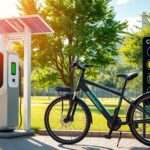Switching to an electric vehicle can substantially lower your carbon footprint, especially if you charge with renewable energy like solar or wind. The emissions savings depend on your location and how clean the grid is—cleaner sources mean bigger benefits. EVs also produce less lifecycle pollution, especially if manufactured in regions powered by renewables. Longer trips and consistent driving enhance environmental gains. To learn how future policies and technology improve EV sustainability, keep exploring these topics.
Key Takeaways
- Electric vehicles emit significantly fewer carbon emissions than gasoline cars, especially when charged with renewable energy.
- Using solar or wind power for charging nearly eliminates electricity-related emissions, maximizing climate benefits.
- Manufacturing EV batteries produces emissions; choosing regions with cleaner grids reduces their environmental impact.
- Longer driving distances and higher annual mileage help EVs offset manufacturing emissions faster.
- Policies promoting renewable energy and used EV markets enhance the overall carbon reduction of electric vehicles.
How Electric Vehicles Cut Carbon Emissions Across the U.S

Electric vehicles substantially reduce carbon emissions across the U.S., especially when charged with cleaner energy sources. By replacing gasoline-powered cars, EVs cut carbon emissions by about two-thirds, making a significant environmental impact. The level of emissions reduction depends on the energy source used for charging; cleaner grids with more renewables lead to greater savings. In states like Vermont and Washington, where the electricity grid is cleaner, EVs can achieve up to 90% emissions reduction. Even in coal-dependent states like West Virginia and Kentucky, EVs still save around 30% of emissions. As grid decarbonization progresses nationwide, the climate benefits of electric vehicles will continue to grow, further decreasing overall carbon emissions across the country. Renewable energy sources are playing a key role in maximizing these environmental benefits, and advancements in electric vehicle technology are making these vehicles more accessible and efficient.
The Role of Electricity Sources in EV Emissions Reductions
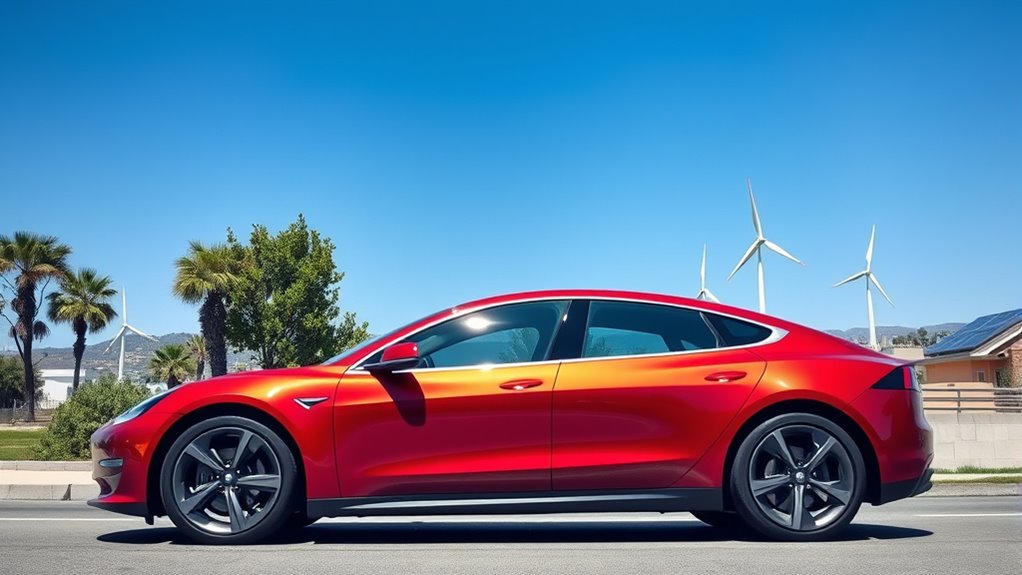
The amount of carbon emissions saved by electric vehicles largely depends on how the electricity powering them is generated. If your electricity comes from renewable energy sources like wind or solar, the EV’s emissions are substantially lower, supporting decarbonization efforts. Conversely, regions relying heavily on coal have higher grid emissions, reducing EVs’ environmental benefits—sometimes only a 30% reduction. Using marginal emissions data gives a clearer picture of EVs’ true impact, highlighting the importance of cleaner electricity. As the grid becomes increasingly decarbonized over time, EVs will deliver even greater emissions reductions. Choosing regions with cleaner electricity generation can maximize your EV’s carbon savings, reinforcing the essential link between energy sourcing and the climate benefits of electric vehicles. Additionally, understanding the Caffeine Content in Espresso can help you stay alert and energized during your eco-friendly journeys. The shift toward renewable energy sources is a key driver in reducing overall emissions from electric vehicles and accelerating the transition to sustainable transportation. Moreover, ongoing advancements in AI security help ensure the safety and reliability of increasingly complex energy grids, supporting the broader goal of decarbonization. Integrating smart grid systems and energy storage solutions will further enhance the efficiency and sustainability of electric vehicle charging infrastructure.
The Lifecycle Impact of Electric Vehicles

Although electric vehicles offer considerable emissions benefits during their use, their overall environmental impact depends heavily on their entire lifecycle. Battery production accounts for about half of an EV’s life cycle emissions, mainly from the electricity used during manufacturing. Producing batteries in regions powered by renewable energy or low-carbon sources substantially reduces these emissions. Recent estimates show battery manufacturing emissions range from 61 to 106 kg CO₂e per kWh, with regional differences affecting the total carbon footprint. While manufacturing emissions are higher initially, EVs typically offset this during their use phase, resulting in a lower overall carbon footprint compared to conventional vehicles. Advances in technology and increased renewable energy use are steadily decreasing the lifecycle impact of EVs, making them a more sustainable transportation option. Incorporating Audi Tuning techniques into electric vehicles can further optimize their performance and efficiency, potentially reducing energy consumption and emissions over their lifetime. Additionally, sustainable manufacturing practices are increasingly being adopted to minimize environmental impacts from production stages. Implementing advanced battery recycling processes can also help mitigate the environmental footprint associated with battery disposal and resource extraction. Moreover, ongoing research into battery technology aims to improve energy density and lifespan, which can further lessen environmental impacts over EVs’ lifecycle.
Manufacturing Emissions and the Mileage Break-Even Point
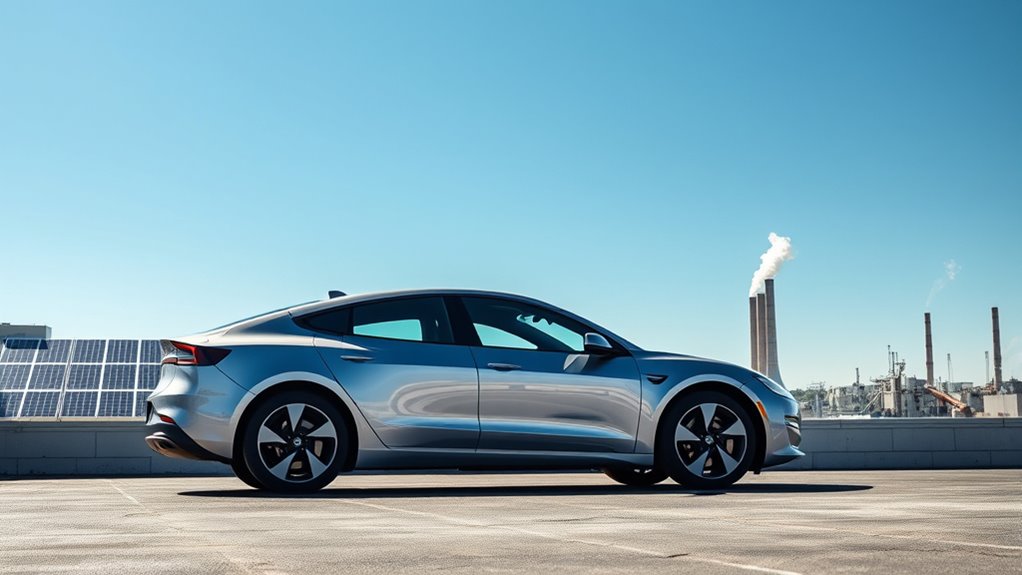
Manufacturing emissions for EV batteries are a significant part of their overall environmental impact, mainly due to the electricity used during production. These emissions contribute roughly half of an EV’s total lifecycle carbon footprint. Producing batteries in regions with renewable or low-carbon electricity, like Europe or the U.S., can greatly reduce manufacturing emissions compared to coal-dependent areas in Asia. While larger batteries with longer mileage capabilities generate more manufacturing emissions, recent advances in technology and cleaner energy sources are lowering this impact. On average, an EV needs to be driven between 28,000 and 68,000 miles to offset the initial manufacturing emissions and achieve a net reduction in carbon footprint. Understanding this mileage break-even point helps you gauge when your EV becomes a truly greener transportation option. Additionally, staying informed about spiritual energy concepts can help individuals align their personal growth with environmentally conscious choices.
The Influence of Driving Habits and Usage Patterns
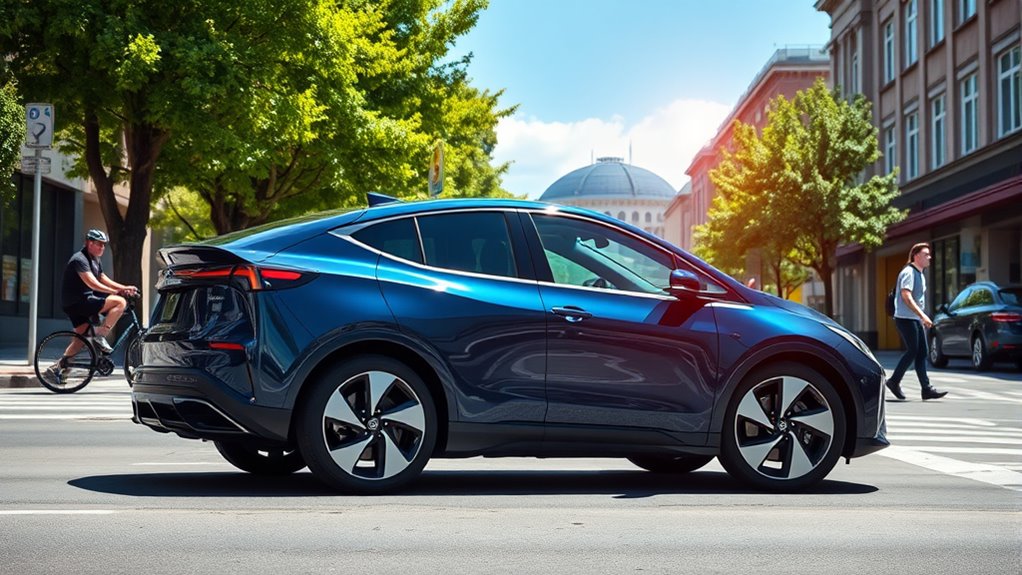
Have you considered how your driving habits influence the environmental benefits of your electric vehicle? Your usage patterns directly impact your car’s carbon footprint and emissions.
Your driving habits shape the true environmental impact of your electric vehicle.
- Short trips or infrequent driving prevent you from offsetting manufacturing emissions, limiting environmental gains.
- Aggressive driving, like rapid acceleration and high speeds, decreases efficiency and raises emissions per mile.
- Longer, consistent mileage helps EVs surpass the break-even point, maximizing climate benefits.
- Policies that promote higher annual miles encourage owning EVs longer, further reducing emissions over time.
- Understanding quorum sensing and how your driving behaviors affect your vehicle’s efficiency can motivate more sustainable choices.
- Additionally, being aware of driver behavior and adopting eco-friendly driving habits can significantly enhance your EV’s environmental impact.
- Optimizing driving patterns by avoiding unnecessary idling and maintaining steady speeds can further improve your vehicle’s efficiency and reduce emissions.
Your driving habits and usage patterns determine whether your EV truly lowers your overall carbon footprint. By driving efficiently and logging substantial miles, you can ensure your vehicle’s positive environmental impact outweighs its initial manufacturing footprint.
Policymaking and Incentives for Sustainable EV Adoption
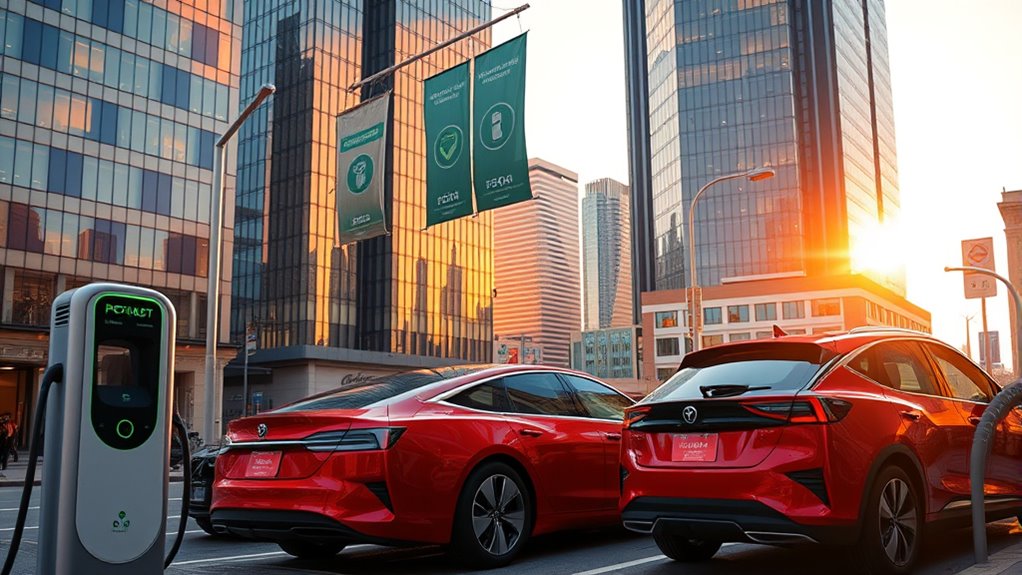
Effective policymaking is essential to expanding sustainable EV adoption and maximizing environmental benefits. Policy incentives should extend to the used vehicle market, as recent laws like the Inflation Reduction Act support this shift. Programs that encourage long-term vehicle use and higher mileage logging help offset manufacturing emissions over an EV’s lifespan. Prioritizing low- and middle-income buyers ensures those who drive more miles benefit from emissions reductions. To further cut the carbon footprint, policies must promote the use of renewable energy for charging, reducing lifecycle emissions. Strategic investments in clean energy infrastructure and sustainable manufacturing practices can enhance the effectiveness of EV incentives. By aligning policies with these goals, you can accelerate the transition to electric vehicles that truly benefit the environment. Additionally, implementing regulatory oversight can help prevent scams and ensure consumers make informed decisions when adopting EVs.
The Power of Renewable Energy in Maximizing Benefits

Charging your electric vehicle with renewable energy, like solar or wind, can nearly eliminate emissions from electricity production. In regions with cleaner grids, EV emissions drop considerably, making them a truly green choice. As renewable energy use grows, EVs become even more environmentally friendly, amplifying their climate benefits. AI security innovations also support the development of smarter grid systems, further enhancing renewable energy integration. Additionally, advancements in battery technology contribute to longer-lasting and more efficient energy storage, maximizing the use of renewable sources. Incorporating energy storage solutions can help balance supply and demand, ensuring consistent use of renewable energy for EV charging.
Renewable Energy Sources
Did you know that the environmental benefits of electric vehicles depend heavily on the energy used to charge them? When you power your EV with renewable energy, like solar power, you drastically cut carbon emissions. Regions with a high share of renewable energy, such as Vermont and Idaho, can even charge EVs with near-zero emissions. The electricity grid’s shift toward cleaner sources amplifies these benefits over time. Consider how:
- Renewable energy can make your EV’s true emissions nearly zero
- Solar power and other renewables reduce reliance on fossil fuels
- Electrify America’s solar-powered charging stations showcase this potential
- A cleaner electricity grid means fewer carbon emissions for every charge
Charging With Solar
Harnessing solar energy to power your EV can maximize its environmental benefits by eliminating indirect emissions entirely. By using rooftop solar panels or solar-powered charging stations, you harness renewable energy that markedly reduces your EV’s carbon footprint. In regions with high solar capacity, EVs charged with solar energy can have near-zero emissions, regardless of the local grid’s cleanliness. Installing rooftop solar panels allows you to generate your own clean energy, decreasing reliance on fossil fuels. As solar energy costs continue to decline and panel efficiency improves, fully renewable EV charging becomes more accessible and impactful. This approach not only boosts the environmental benefits of your EV but also promotes sustainability by harnessing the power of renewable energy, creating a cleaner, greener future.
Addressing Equity and Access in EV Incentive Programs

While electric vehicle (EV) incentive programs aim to promote cleaner transportation, they often overlook issues of equity and access. Most incentives tend to benefit higher-income households, leaving lower- and middle-income groups behind. Despite EVs costing nearly $12,000 more upfront, lower-income households often log more miles, gaining greater emissions benefits over time. Unfortunately, current policies don’t fully consider usage patterns, limiting their environmental and economic impact for many. To address this, policymakers should:
EV incentives often favor wealthier households, missing opportunities to support lower-income communities and maximize environmental benefits.
- Extend incentives to used EV markets
- Make incentives accessible to lower-income communities
- Recognize different socioeconomic needs
- Ensure fair distribution of climate benefits
Future Trends and Opportunities for Greener Transportation

As renewable energy sources become more widespread, the environmental benefits of electric vehicles will grow considerably. With cleaner electricity, EVs’ carbon footprint will shrink even further, especially as UK grid emissions are projected to drop over 70% by the late 2020s. Advances in battery technology, powered by renewable energy and more efficient manufacturing, will lower lifecycle emissions for future EVs. This shift, combined with decarbonized energy grids, paves the way for achieving global climate goals, including those in the Paris Agreement. Policies promoting renewable energy expansion and building clean transportation infrastructure will accelerate the switch to green transportation. Innovations like vehicle-to-grid technology and solar-powered charging stations will create new opportunities to reduce transportation’s environmental impact, making sustainable mobility more accessible and effective.
Frequently Asked Questions
Do Electric Cars Have a Lower Carbon Footprint?
You wonder if electric cars have a lower carbon footprint. The answer is yes, especially when charged with clean energy. They produce fewer emissions over their lifetime compared to gasoline cars, despite higher initial manufacturing emissions. As electricity grids get greener, your EV’s carbon footprint drops even more. So, by choosing an electric vehicle, you’re helping reduce overall emissions and supporting a more sustainable future.
How Do Electric Vehicles Contribute to Reducing Carbon Emissions?
Electric vehicles help cut your carbon emissions by emitting less CO₂ over their lifetime, especially when charged with clean energy. You reduce pollution as EVs produce fewer greenhouse gases during use, offsetting their higher manufacturing emissions. As your electricity grid gets greener, your EV’s climate benefits grow even more. By choosing an EV and supporting renewable energy, you directly contribute to lowering transportation-related carbon footprints.
How Much CO2 Do EVS Save?
You wonder how much CO₂ EVs save. When you drive an electric vehicle, you cut your emissions by about two-thirds compared to gas-powered cars, depending on your state’s electricity. In cleaner-grid states, savings can reach up to 90%. While manufacturing produces more initial emissions, these are offset after about 28,000 to 68,000 miles. As renewable energy grows, your EV’s lifetime emissions will decrease even more.
Do Electric Vehicles Actually Help the Environment?
You might wonder if electric vehicles really help the environment. Well, they do—especially in regions where electricity comes from renewable sources, reducing emissions by up to 90%. Although manufacturing batteries creates some initial pollution, this is offset during use. By choosing an EV, you contribute to lower overall carbon footprints, especially as clean energy becomes more widespread. So, yes, your EV helps protect the planet.
Conclusion
By choosing electric vehicles, you’re planting seeds for a greener future, watching your carbon footprint shrink like a fading echo. As you embrace cleaner energy and smarter driving habits, you become part of a vibrant tapestry transforming roads into arteries of sustainability. Together, your journey illuminates a path where innovation and nature dance in harmony, turning everyday drives into powerful strokes of change that brighten our world for generations to come.


